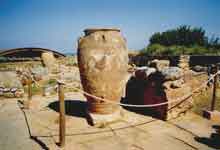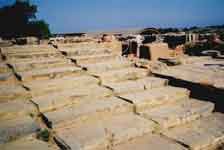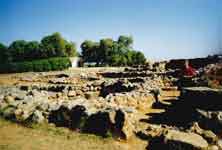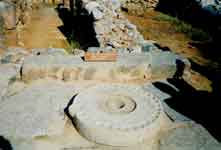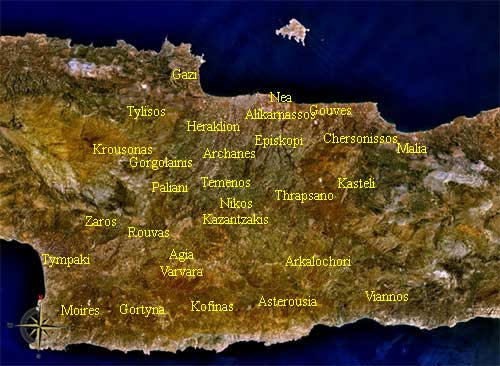.
Administrative Region : Crete
Regional unit : Heraklion
Malia (Greek: Μάλια) is a coastal town and a former municipality in the Heraklion peripheral unit, Crete, Greece. Since the 2011 local government reform it is part of the municipality Hersonissos, of which it is a municipal unit.[1] It lies 34 km east of Heraklion, the Cretan capital city. The town (pop. 3,722 in 2001) was the seat of the municipality of Mália (pop. 6,212), located in the northeast corner of Heraklion Prefecture. The municipal unit also includes the villages of Mochos (Greek: Μοχός) (1,155), Krasi (Greek: Κράσι) (348), and Stalis (Greek: Σταλίδα) (987), and has a total land area of 60.720 km². The town is a tourist attraction, primarily for its significant archaeological site and nightlife. The Minoan town ruins lie three km east of the site and cover an area of approximately 1 km². The original name for the town is not known.
History

Malia [Source]
The palace of Malia, dating from the Middle Bronze Age, was destroyed by an earthquake during the Late Bronze Age;[2] Knossos and other sites were also destroyed at that time. The palace was later rebuilt toward the end of the Late Bronze Age. Most of the ruins visible today date from this second period of construction. The palace features a giant central courtyard, 48m x 23m in size. On the south side are two sets of steps leading upwards and a maze of tiny rooms. Also here is a strange carved stone called a kernos stone, which looks like a millstone with a cup attached to the side of it. On the north side of the courtyard were storage rooms with giant earthenware pithos jars, up to two metres tall. These were used for holding grain, olive oil and other liquids; the floor of these rooms has a complex drainage system for carrying away spilled liquids.
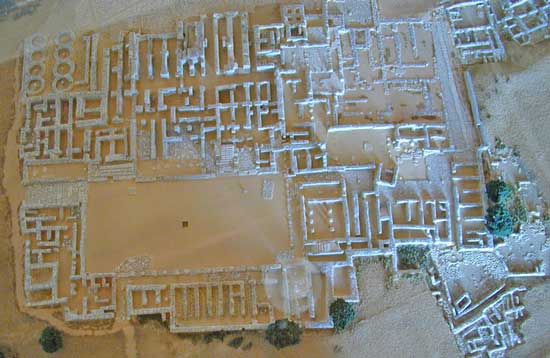
Model of the remains of the palace of Malia [Source]
The palace of Malia was discovered in 1915 by Hadzidakis, a Greek archaeologist. It was fully excavated from 1922 onwards by the French School at Athens in collaboration with Greek scholars. Importantly, the palace was surrounded by a Minoan town which has only recently been uncovered. Excavation is ongoing. Important parts of the old and new excavations are covered by a series of large semi-transparent roofs, which protect them from the elements. In places tourists are allowed to wander among the ruins; in others, walkways allow passage above. There are rooms which have been identified as metal workshops, ceramic workshops and meeting rooms; there is also a large residential dwelling with on-suite bath, which is similar to a design at Phaistos, both taking advantage of expansive views.[3]

The Bees of Malia, two golden bees holding a drop of honey. [Source]
Malia the Resort
Modern day Malia is a holiday resort, tourism and commerce are the main economic activities in the town, with plenty of hotels, restaurants, gift shops, bars and nightclubs. Malia has become one of the most popular tourist locations of Crete, and one of the most popular in Europe, rivalling Ibiza and Magaluf. It is mainly visited by young British tourists. The prominence of Malia as one of the leading spots for nightlife in Europe is cemented by the attraction of big name DJs and events. The Main Strip is home to many bars, clubs, taverns and restaurants. This is supported by the many close by hotels and apartments in Malia and the immediate area. Malia has a fine sandy beach which starts from the bottom of the strip and continues towards the East near to the Minoan palace of Malia.
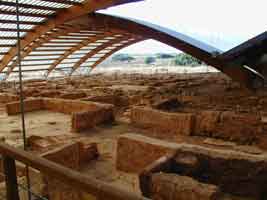
Division of the municipality of Malia with a population 6212 in 2001:
- Malia / Δ.δ. Μαλίων -- τα Μάλια [ 3.722 ]
- Krasion / Δ.δ. Κρασίου -- το Κράσιον [ 348 ]
- Mochos / Δ.δ. Μοχού [ 2.142 ]
References
^ Kallikratis law Greece Ministry of Interior (Greek)
^ Mallia archaeological site
^ C. Michael Hogan. 2007. Phaistos fieldnotes, The Modern Antiquarian
^ "Sex Drugs Booze Violence welcome To Malia". Daily Mail. Retrieved 01/08/2008.
External links
During the summer of 2008, Malia attracted increased attention from the British news media, centering on the wild nightlife and the antisocial behaviour attributed to this. Various newspapers and television news services such as BBC News and GMTV sent reporters to highlight the growing concern at the violence and alcohol problems in the popular resort.[4] This behaviour was also brought to light in the 2002 Sky 1 documentary titled Sex on the Beach which was filmed in Malia and followed the experiences of different groups of British holidaymakers during their stay with an emphasis on their drinking binges and sexual promiscuity.
|
Municipalities of the Heraklion Prefecture
Agia Varvara | Archanes | Arkalochori | Asterousia | Chersonissos | Episkopi | Gazi | Gorgolainis | Gortyna | Gouves | Heraklion | Kasteli | Kofinas | Krousonas | Malia | Moires | Nea Alikarnassos | Nikos Kazantzakis | Paliani | Rouvas | Temenos | Thrapsano | Tylisos | Tympaki | Viannos | Zaros |
| Municipal unit Malia |
|---|
| Municipal Community Malia |
| Malia (Μάλια, τα) |
| Municipal Community Mochos |
| Mochos (Μοχός, ο) |
| Σταλίς, η |
| Community Krasi |
| Krasi (Κράσιον, το) |
| Ancient Greece
Science, Technology , Medicine , Warfare, , Biographies , Life , Cities/Places/Maps , Arts , Literature , Philosophy ,Olympics, Mythology , History , Images Medieval Greece / Byzantine Empire Science, Technology, Arts, , Warfare , Literature, Biographies, Icons, History Modern Greece Cities, Islands, Regions, Fauna/Flora ,Biographies , History , Warfare, Science/Technology, Literature, Music , Arts , Film/Actors , Sport , Fashion --- |
Retrieved from "http://en.wikipedia.org/"
All text is available under the terms of the GNU Free Documentation License


